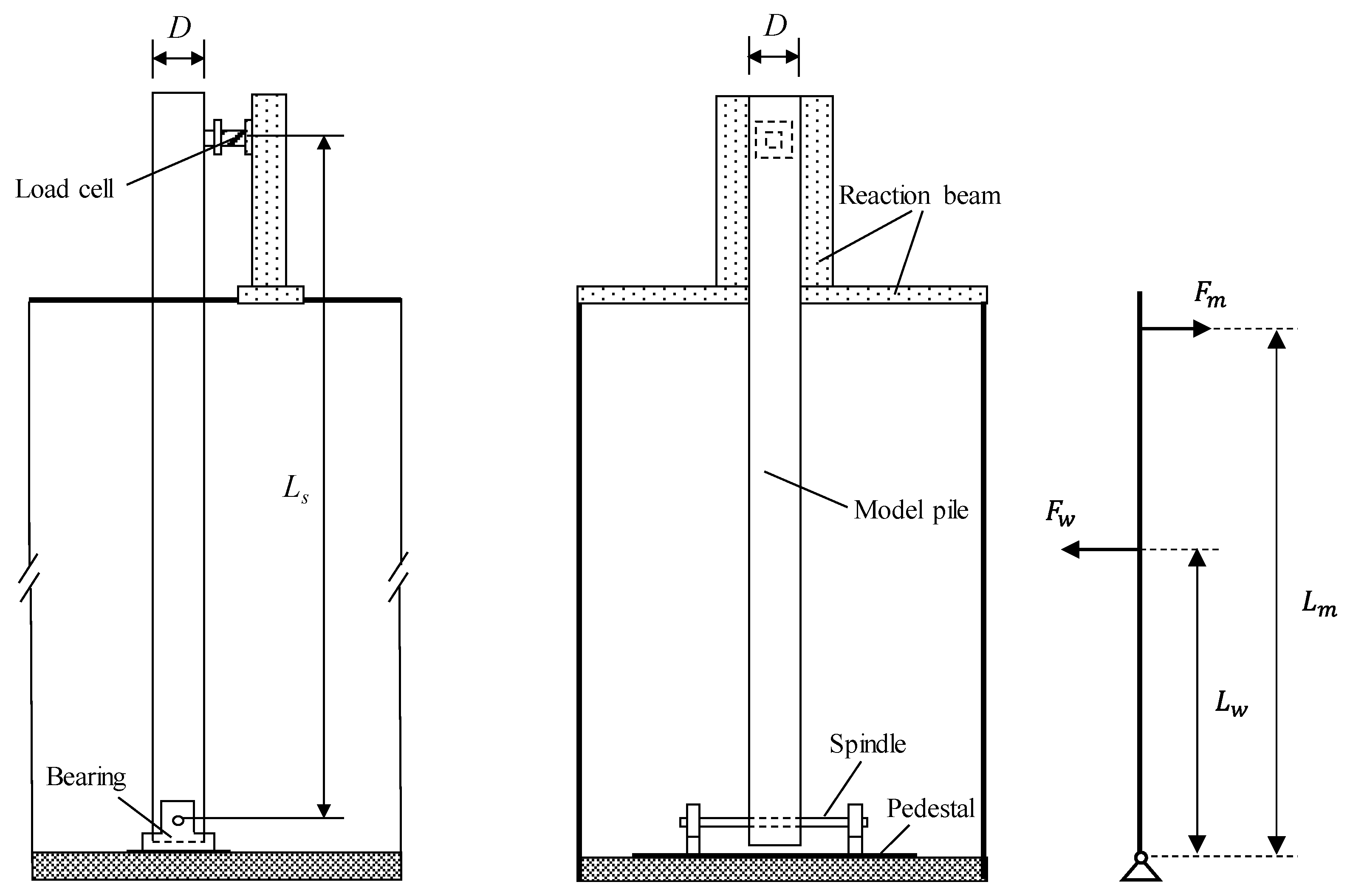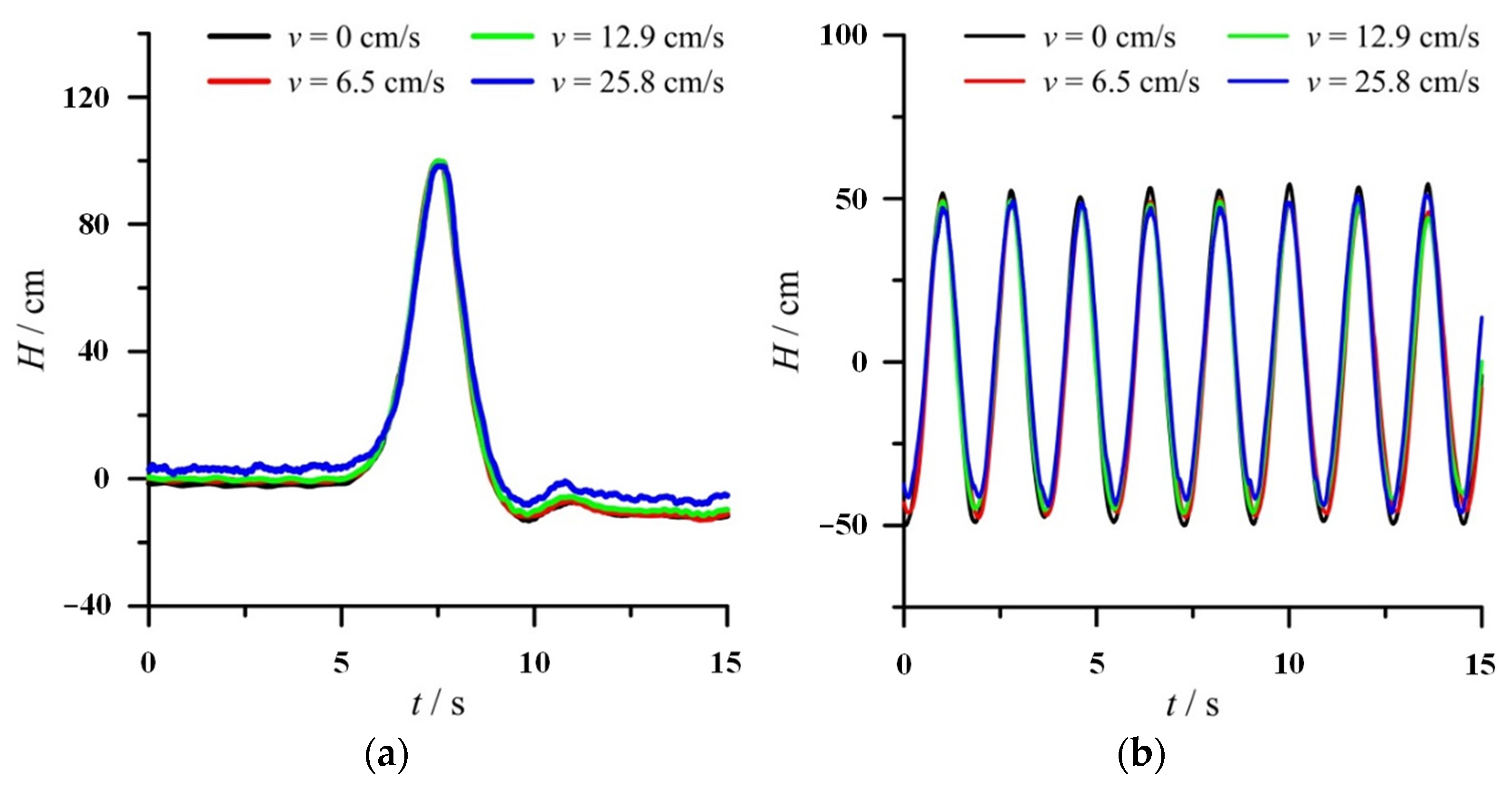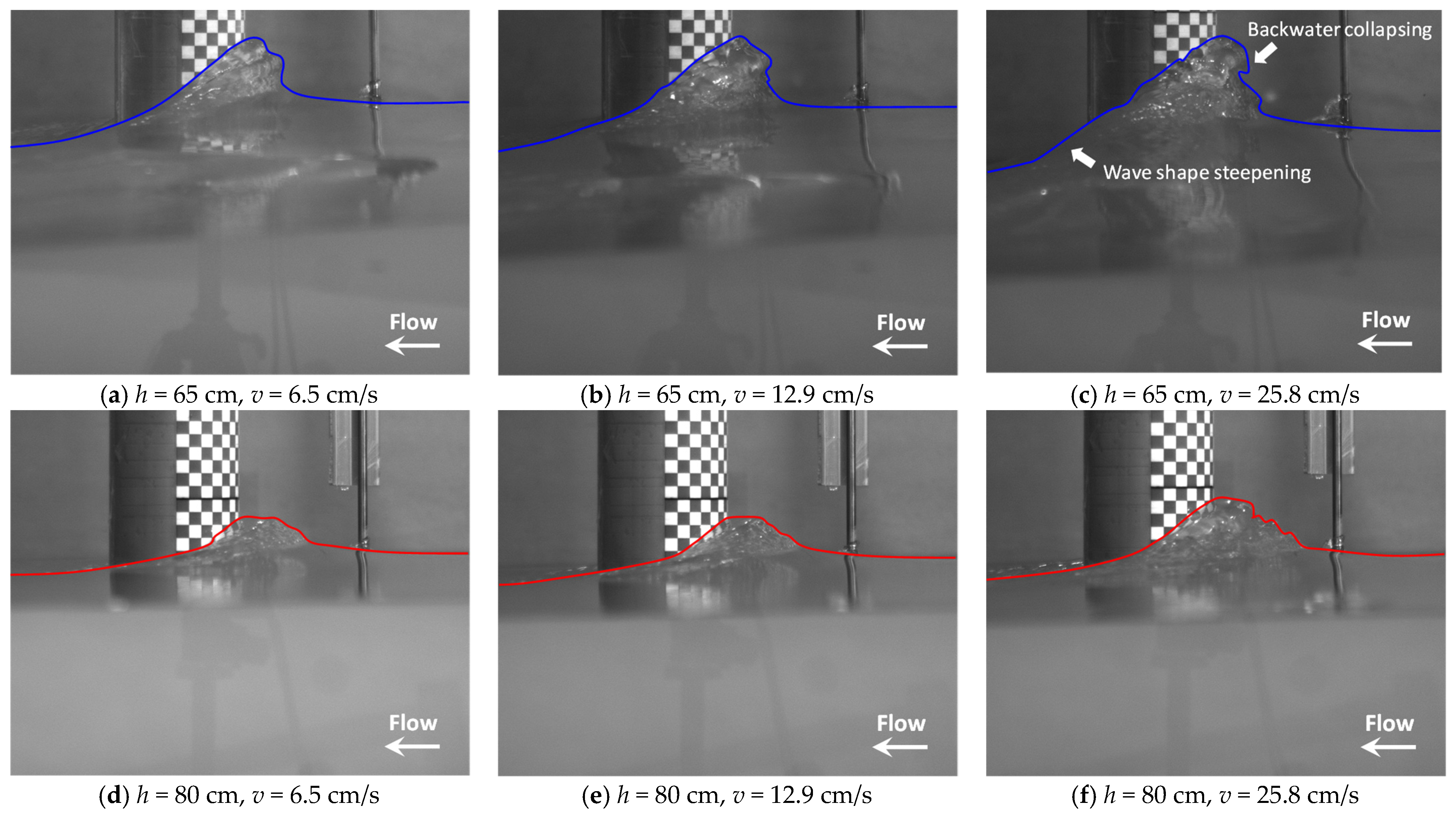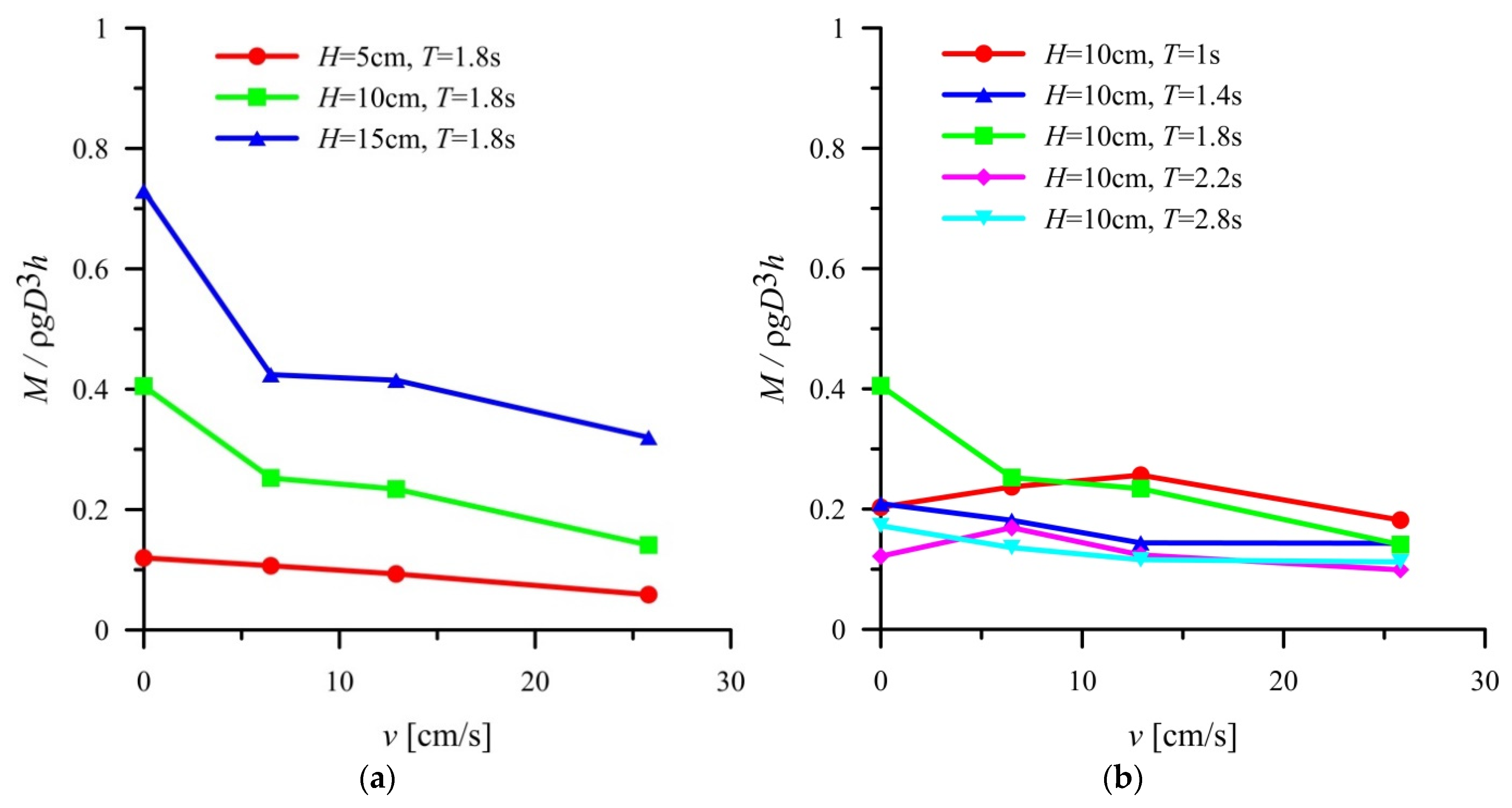Influence of Currents on the Breaking Wave Forces Acting on Monopiles over an Impermeable Slope
Abstract
:1. Introduction
2. Laboratory Experiments
2.1. Experimental Setup
2.2. Test Conditions
2.3. Post-Processing
3. Results and Discussion
3.1. Solitary Waves
3.2. Regular Waves
4. Conclusions
Author Contributions
Funding
Institutional Review Board Statement
Informed Consent Statement
Data Availability Statement
Acknowledgments
Conflicts of Interest
References
- Komušanac, I. Wind Energy in Europe in 2018; Wind Europe: Brussels, Belgium, 2018. [Google Scholar] [CrossRef]
- Wienke, J.; Sparboom, U.; Oumeraci, H. Breaking Wave Impact on a Slender Cylinder. In Proceedings of the Coastal Engineering 2000, Sydney, Australia, 16–21 July 2000; American Society of Civil Engineers: Sydney, Australia, 23 March 2001; pp. 1787–1798. [Google Scholar]
- Wienke, J.; Oumeraci, H. Breaking wave impact force on a vertical and inclined slender pile—Theoretical and large-scale model investigations. Coast. Eng. 2005, 52, 435–462. [Google Scholar] [CrossRef]
- Mo, W.; Jensen, A.; Liu, P.L.-F. Plunging solitary wave and its interaction with a slender cylinder on a sloping beach. Ocean Eng. 2013, 74, 48–60. [Google Scholar] [CrossRef]
- Xiao, H.; Huang, W. Three-Dimensional Numerical Modeling of Solitary Wave Breaking and Force on a Cylinder Pile in a Coastal Surf Zone. J. Eng. Mech. 2015, 141, A4014001. [Google Scholar] [CrossRef]
- Chella, M.A.; Bihs, H.; Myrhaug, D.; Muskulus, M. Breaking solitary waves and breaking wave forces on a vertically mounted slender cylinder over an impermeable sloping seabed. J. Ocean Eng. Mar. Energy 2016, 3, 1–19. [Google Scholar] [CrossRef]
- Vested, M.H.; Carstensen, S.; Christensen, E.D. Experimental study of wave kinematics and wave load distribution on a vertical circular cylinder. Coast. Eng. 2020, 157, 103660. [Google Scholar] [CrossRef]
- Chiapponi, L.; Addona, F.; Díaz-Carrasco, P.; Losada, M.; Longo, S. Statistical analysis of the interaction between wind-waves and currents during early wave generation. Coast. Eng. 2020, 159, 103672. [Google Scholar] [CrossRef]
- Tu, Z.; Yao, J.; Huang, M.; Lou, W. Investigation of Coupling Effects of Wave, Current, and Wind on a Pile Foundation. Sustainability 2022, 14, 14272. [Google Scholar] [CrossRef]
- Miles, J.; Martin, T.; Goddard, L. Current and wave effects around windfarm monopile foundations. Coast. Eng. 2017, 121, 167–178. [Google Scholar] [CrossRef] [Green Version]
- Chen, L.; Stagonas, D.; Santo, H.; Buldakov, E.; Simons, R.; Taylor, P.; Zang, J. Numerical modelling of interactions of waves and sheared currents with a surface piercing vertical cylinder. Coast. Eng. 2019, 145, 65–83. [Google Scholar] [CrossRef]
- Chen, L.; Zhai, H.; Wang, P.; Jeng, D.-S.; Zhang, Q.; Wang, S.; Duan, L.; Liu, Y. Physical modeling of combined waves and current propagating around a partially embedded monopile in a porous seabed. Ocean Eng. 2020, 205, 107307. [Google Scholar] [CrossRef]
- Chen, L.; Yang, X.; Li, L.; Wu, W.; El Naggar, M.H.; Wang, K.; Chen, J. Numerical Analysis of the Deformation Performance of Monopile under Wave and Current Load. Energies 2020, 13, 6431. [Google Scholar] [CrossRef]
- Roy, S.; Debnath, K.; Mazumder, B.S. Distribution of turbulent eddies behind a monopile for vortex lock-on condition due to wave current combined flow. Coast. Eng. 2018, 131, 70–87. [Google Scholar] [CrossRef]
- Buljac, A.; Kozmar, H.; Yang, W.; Kareem, A. Concurrent wind, wave and current loads on a monopile-supported offshore wind turbine. Eng. Struct. 2022, 255, 113950. [Google Scholar] [CrossRef]
- Zhang, B.; Li, J.; Liu, W.; Zhang, H.; Shi, P.; Fu, X. Experimental study on dynamic characteristics of a monopile foundation based on local scour in combined waves and current. Ocean Eng. 2022, 266, 113003. [Google Scholar] [CrossRef]
- Lin, J.; Zhang, J.-S.; Sun, K.; Wei, X.-L.; Guo, Y.-K. Numerical analysis of seabed dynamic response in vicinity of mono-pile under wave-current loading. Water Sci. Eng. 2020, 13, 74–82. [Google Scholar] [CrossRef]
- Li, J.; Zhang, B.; Shen, C.; Fu, X.; Li, W. Experimental Study on Local Scour Depth around Monopile Foundation in Combined Waves and Current. Sustainability 2021, 13, 13614. [Google Scholar] [CrossRef]
- Basack, S.; Goswami, G.; Dai, Z.-H.; Baruah, P. Failure-Mechanism and Design Techniques of Offshore Wind Turbine Pile Foundation: Review and Research Directions. Sustainability 2022, 14, 12666. [Google Scholar] [CrossRef]
- Chen, B.; Li, S. Experimental Study of Local Scour around a Vertical Cylinder under Wave-Only and Combined Wave-Current Conditions in a Large-Scale Flume. J. Hydraul. Eng. 2018, 144, 04018058. [Google Scholar] [CrossRef]
- Qi, W.-G.; Li, C.-F.; Jeng, D.-S.; Gao, F.-P.; Liang, Z. Combined wave-current induced excess pore-pressure in a sandy seabed: Flume observations and comparisons with theoretical models. Coast. Eng. 2019, 147, 89–98. [Google Scholar] [CrossRef]
- Qi, W.; Gao, F. Equilibrium scour depth at offshore monopile foundation in combined waves and current. Sci. China Technol. Sci. 2014, 57, 1030–1039. [Google Scholar] [CrossRef] [Green Version]
- Sumer, B.M.; Fredsøe, J. Scour around Pile in Combined Waves and Current. J. Hydraul. Eng. 2001, 127, 403–411. [Google Scholar] [CrossRef]
- Welzel, M.; Schendel, A.; Hildebrandt, A.; Schlurmann, T. Scour development around a jacket structure in combined waves and current conditions compared to monopile foundations. Coast. Eng. 2019, 152, 103515. [Google Scholar] [CrossRef]
- Wu, M.; De Vos, L.; Chavez, C.E.A.; Stratigaki, V.; Fazeres-Ferradosa, T.; Rosa-Santos, P.; Taveira-Pinto, F.; Troch, P. Large Scale Experimental Study of the Scour Protection Damage around a Monopile Foundation under Combined Wave and Current Conditions. J. Mar. Sci. Eng. 2020, 8, 417. [Google Scholar] [CrossRef]
- Zhu, J.; Gao, Y.; Wang, L.; Li, W. Experimental investigation of breaking regular and irregular waves slamming on an offshore monopile wind turbine. Mar. Struct. 2022, 86, 103270. [Google Scholar] [CrossRef]
- Irschik, K.; Sparboom, U.; Oumeraci, H. Breaking Wave Loads on a Slender Pile in Shallow Water. In Proceedings of the Coastal Engineering 2004, Lisbon, Portugal, 19–24 September 2004; World Scientific Publishing Company: Singapore, 2005; pp. 568–580. [Google Scholar]
- Kamath, A.; Chella, M.A.; Bihs, H.; Arntsen, Ø.A. Breaking wave interaction with a vertical cylinder and the effect of breaker location. Ocean Eng. 2016, 128, 105–115. [Google Scholar] [CrossRef]
- Lara, J.L.; Losada, I.; Liu, P. Breaking waves over a mild gravel slope: Experimental and numerical analysis. J. Geophys. Res. Earth Surf. 2006, 111, C11019. [Google Scholar] [CrossRef]
- Goda, Y.; Morinobu, K. Breaking Wave Heights on Horizontal Bed Affected by Approach Slope. Coast. Eng. J. 1998, 40, 307–326. [Google Scholar] [CrossRef]
- Kirkgöz, M. Breaking wave impact on vertical and sloping coastal structures. Ocean Eng. 1995, 22, 35–48. [Google Scholar] [CrossRef]
- Allsop, N.W.H.; Durand, N.; Hurdle, D.P. Influence of Steep Seabed Slopes on Breaking Waves for Structure Design. In Proceedings of the Coastal Engineering 1998, Copenhagen, Denmark, 22–26 June 1998; American Society of Civil Engineers: Copenhagen, Denmark, 1999; pp. 906–919. [Google Scholar]
- Zeng, X.; Shi, W.; Michailides, C.; Zhang, S.; Li, X. Numerical and experimental investigation of breaking wave forces on a monopile-type offshore wind turbine. Renew. Energy 2021, 175, 501–519. [Google Scholar] [CrossRef]
- Bredmose, H.; Slabiak, P.; Sahlberg-Nielsen, L.; Schlütter, F. Dynamic Excitation of Monopiles by Steep and Breaking Waves: Experimental and Numerical Study. In Proceedings of the Volume 8: Ocean Renewable Energy, Washington, DC, USA, 7 June 1981; American Society of Mechanical Engineers: Nantes, France, 2013; p. V008T09A062. [Google Scholar]
- Chella, M.A.; Tørum, A.; Myrhaug, D. An Overview of Wave Impact Forces on Offshore Wind Turbine Substructures. Energy Procedia 2012, 20, 217–226. [Google Scholar] [CrossRef] [Green Version]
- Yang, H.; Guo, Z.; Wang, L.; Dou, Y.; Liu, Z. Experimental study on wave-induced seabed response and force on the pipeline shallowly buried in a submerged sandy slope. Ocean Eng. 2022, 251, 111153. [Google Scholar] [CrossRef]
- Dou, Y.; Guo, Z.; Gao, Y.; Wang, L.; Yang, H.; Liu, Z. Experimental investigations on the stability of clayey sloping seabed under wave actions. Ocean Eng. 2021, 239, 109805. [Google Scholar] [CrossRef]
- Yang, H.; Guo, Z.; Wang, L.; Qi, W. Peak uplift resistance of offshore slender structures shallowly buried in the sloping seabed considering wave actions. Appl. Ocean Res. 2022, 129, 103388. [Google Scholar] [CrossRef]
- Grilli, S.T.; Svendsen, I.A.; Subramanya, R. Breaking Criterion and Characteristics for Solitary Waves on Slopes. J. Waterw. Port, Coastal, Ocean Eng. 1997, 123, 102–112. [Google Scholar] [CrossRef] [Green Version]
- He, F.; Zhang, H.; Huang, C.; Liu, M. Numerical investigation of the solitary wave breaking over a slope by using the finite particle method. Coast. Eng. 2019, 156, 103617. [Google Scholar] [CrossRef]
- Battjes, J.A. Computation of Set-Up, Longshore Currents, Run-up and Overtopping Due to Wind-Generated Waves; TU Delft: Delft, The Netherland, 1974. [Google Scholar]
- Galvin, C.J. Breaker type classification on three laboratory beaches. J. Geophys. Res. Atmos. 1968, 73, 3651–3659. [Google Scholar] [CrossRef]










| Parameter | Prototype Scale | Model Scale |
|---|---|---|
| Pile diameter D | 6 m/12 m | 10 cm/20 cm |
| Maximum water depth h | 48 m | 80 cm |
| Maximum wave height H | 9 m | 15 cm |
| Mean surface current velocity | 1 m/s | 12.9 cm/s |
| Maximum surface current velocity vm | 2 m/s | 25.8 cm/s |
| Test No. | Wave Type | Pile Diameter | Water Depth | Wave Height | Wave Period | Wave Length | BreakingIndex | Breaker Type | Current Velocity |
|---|---|---|---|---|---|---|---|---|---|
| D [cm] | h [cm] | H [cm] | T [s] | L [m] | S0/ξ | - | v [cm/s] | ||
| 1 | solitary | 10 | 65 | 5 | - | - | 0.49 | Non-breaking | 0/6.5/12.9/25.8 |
| 2 | solitary | 10 | 65 | 10 | - | - | 0.35 | Surging | 0/6.5/12.9/25.8 |
| 3 | solitary | 10 | 65 | 15 | - | - | 0.28 | Plunging | 0 */6.5/12.9/25.8 |
| 4 | solitary | 10 | 70 | 5 | - | - | 0.51 | Non-breaking | 0/6.5/12.9/25.8 |
| 5 | solitary | 10 | 70 | 10 | - | - | 0.36 | Surging | 0/6.5/12.9/25.8 |
| 6 | solitary | 10 | 70 | 15 | - | - | 0.29 | Plunging | 0/6.5/12.9/25.8 |
| 7 | solitary | 10 | 75 | 5 | - | - | 0.53 | Non-breaking | 0/6.5/12.9/25.8 |
| 8 | solitary | 10 | 75 | 10 | - | - | 0.37 | Surging | 0/6.5/12.9/25.8 |
| 9 | solitary | 10 | 75 | 15 | - | - | 0.30 | Plunging | 0/6.5/12.9/25.8 |
| 10 | solitary | 10 | 80 | 5 | - | - | 0.54 | Non-breaking | 0/6.5/12.9/25.8 |
| 11 | solitary | 10 | 80 | 10 | - | - | 0.38 | Non-breaking | 0/6.5/12.9/25.8 |
| 12 | solitary | 10 | 80 | 15 | - | - | 0.31 | Surging | 0/6.5 */12.9/25.8 * |
| 13 | solitary | 20 | 80 | 5 | - | - | 0.54 | Non-breaking | 0/6.5/12.9/25.8 |
| 14 | solitary | 20 | 80 | 10 | - | - | 0.38 | Non-breaking | 0/6.5/12.9/25.8 |
| 15 | solitary | 20 | 80 | 15 | - | - | 0.31 | Surging | 0 */6.5/12.9/25.8 * |
| 16 | regular | 20 | 80 | 5 | 1.8 | 5.06 | 0.90 | Plunging | 0/6.5/12.9/25.8 |
| 17 | regular | 20 | 80 | 10 | 1 | 1.56 | 0.35 | Spilling | 0/6.5/12.9/25.8 |
| 18 | regular | 20 | 80 | 10 | 1.4 | 3.06 | 0.49 | Spilling | 0/6.5/12.9/25.8 |
| 19 | regular | 20 | 80 | 10 | 1.8 | 5.06 | 0.63 | Plunging | 0/6.5/12.9/25.8 |
| 20 | regular | 20 | 80 | 10 | 2.2 | 7.56 | 0.78 | Plunging | 0/6.5/12.9/25.8 |
| 21 | regular | 20 | 80 | 10 | 2.6 | 10.55 | 0.92 | Plunging | 0/6.5/12.9/25.8 |
| 22 | regular | 20 | 80 | 15 | 1.8 | 5.06 | 0.52 | Plunging | 0 */6.5/12.9/25.8 |
Disclaimer/Publisher’s Note: The statements, opinions and data contained in all publications are solely those of the individual author(s) and contributor(s) and not of MDPI and/or the editor(s). MDPI and/or the editor(s) disclaim responsibility for any injury to people or property resulting from any ideas, methods, instructions or products referred to in the content. |
© 2022 by the authors. Licensee MDPI, Basel, Switzerland. This article is an open access article distributed under the terms and conditions of the Creative Commons Attribution (CC BY) license (https://creativecommons.org/licenses/by/4.0/).
Share and Cite
Liu, S.; Liu, Z. Influence of Currents on the Breaking Wave Forces Acting on Monopiles over an Impermeable Slope. Sustainability 2023, 15, 129. https://doi.org/10.3390/su15010129
Liu S, Liu Z. Influence of Currents on the Breaking Wave Forces Acting on Monopiles over an Impermeable Slope. Sustainability. 2023; 15(1):129. https://doi.org/10.3390/su15010129
Chicago/Turabian StyleLiu, Shan, and Zhenyu Liu. 2023. "Influence of Currents on the Breaking Wave Forces Acting on Monopiles over an Impermeable Slope" Sustainability 15, no. 1: 129. https://doi.org/10.3390/su15010129





